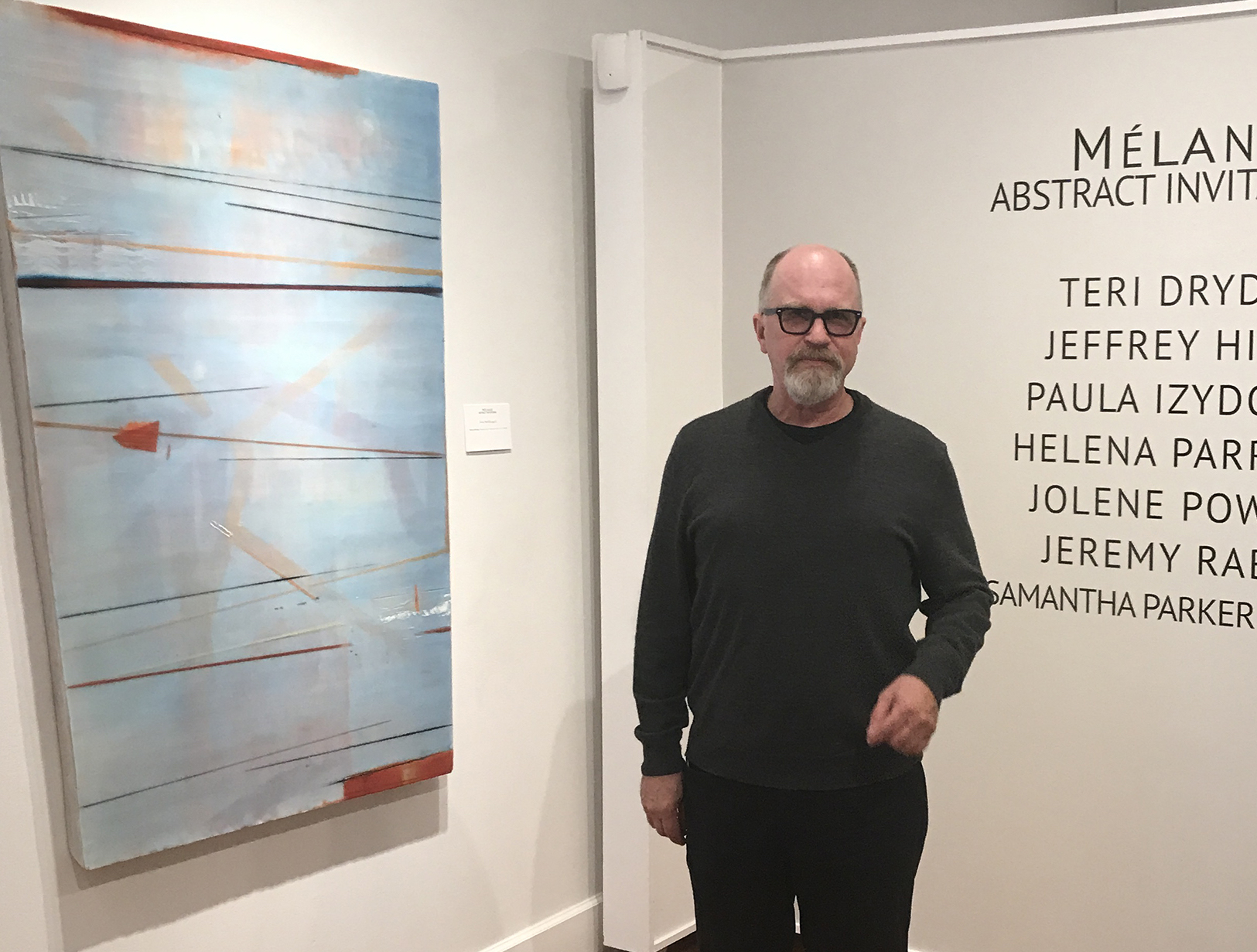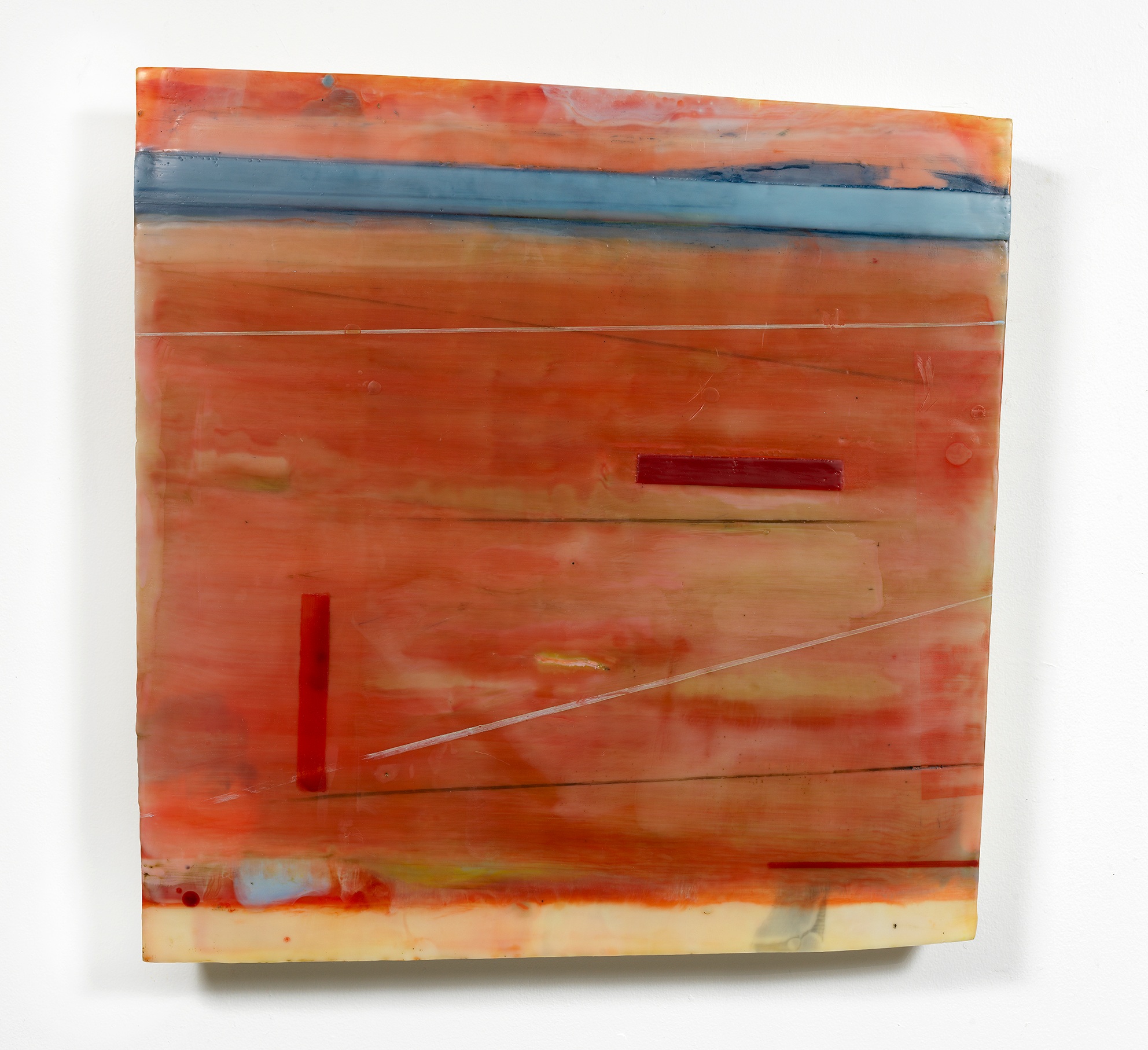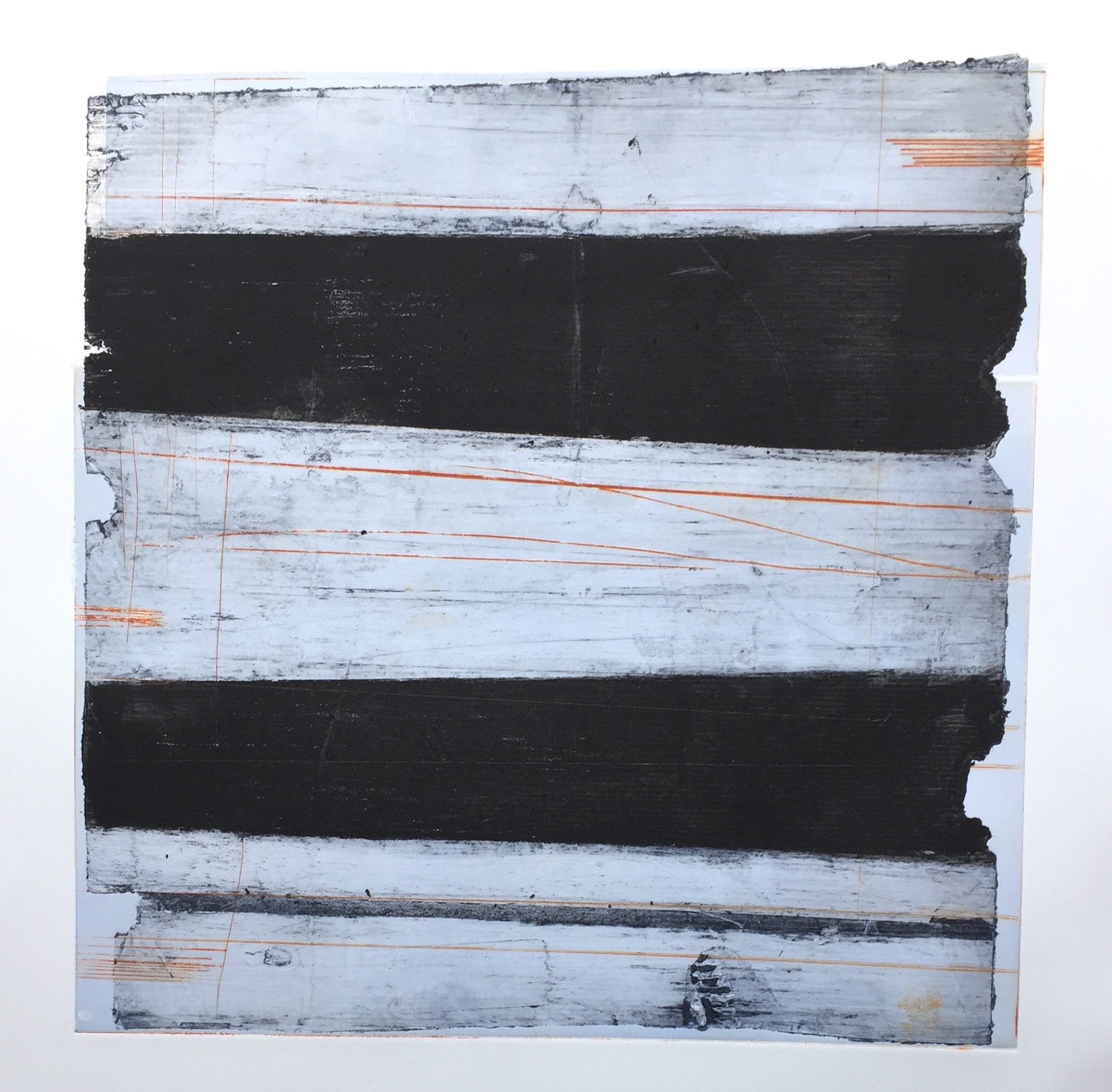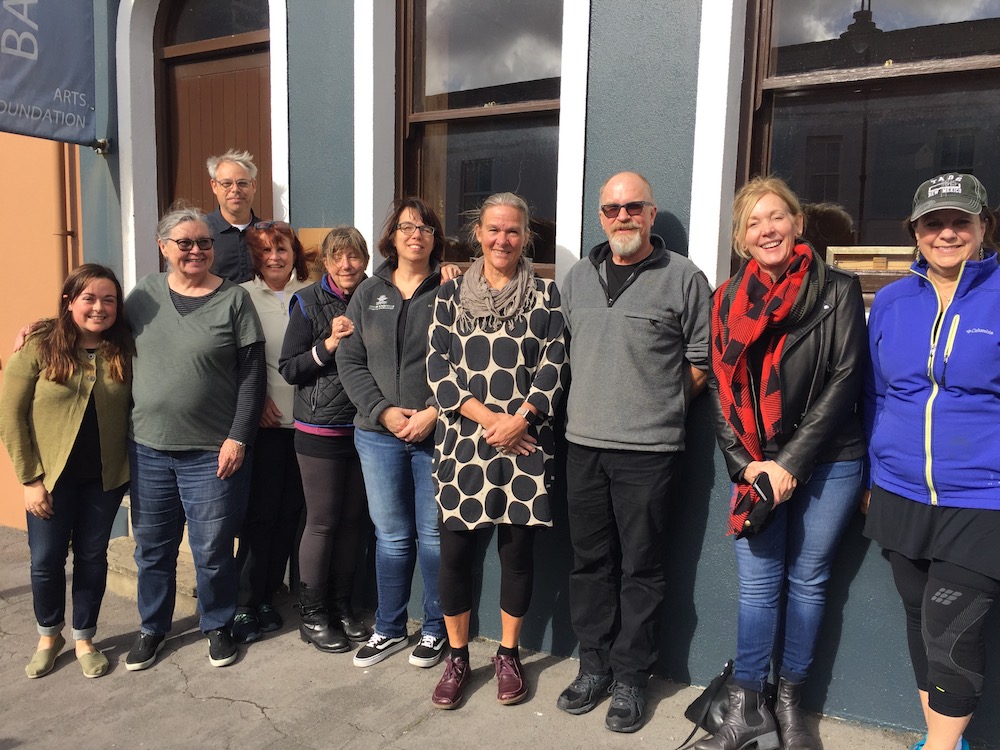Featured Artist/Traveler: Jeffrey Hirst - Mixing Mediums
I have long admired Jeff Hirst’s mixed media paintings and prints, which emerge intuitively from his exploration of different techniques and materials. His inquisitive nature has inspired him to merge innovative new combinations of mediums; most interestingly, the junction of encaustic paint and printmaking. His work is heavily influenced by urban structures, specifically living and working in Chicago.
————————————————————————————————————————————————-
Thanks for sharing your story with us Jeff! To start, can you give us a short version of your background - where did you grow up, did you go to art school, where are you based now?
I grew up in Illinois and Wisconsin living in suburban Chicago and rural Wisconsin. I received my B.F.A from the University of Minnesota and my M.F.A. from Louisiana State University. For many years I lived in Minneapolis and also in Oakland. I now live and work in Chicago.
“Aquatic Brume” 27” x 26” encaustic and oil on shaped panel
What is your core approach to art-making and creativity. What inspires you to create?
For a long time I have approached art-making as a builder: assembling images, taking the images apart and then reassembling. I work this way whether working in painting, printmaking, or sculpture. Working intuitively is how I generally start working. I begin with a rough idea of the vision I have in mind while also letting the work evolve during the creative process. As a child, I was always building things and often would build structures from wood. I think this was my early “training” where I learned to think intuitively.
My belief is that we create to answer questions that we might have about the world and how our piece fits into the puzzle. My own work draws on the influence of urban structure and how cities or urban environments come to influence us. My work draws on linear structure, grids, decaying surfaces, and pattern and repetition. Like so many artists, I have this underlying drive to make and create.
“Harmonic Wave” 26” x 25” encaustic and oil on shaped panel
You currently work in encaustic (a beeswax and damar resin paint) and have also combined encaustic and printmaking to unique effect. What made you choose encaustic as your medium, and how did the combining of these different processes come to be?
I came to working in encaustic in 1996 after having worked in acrylic/ mixed media painting. Before I was making encaustic paintings, I was mixing large quantities of a water-putty material with acrylic and pouring it onto the paintings. The work was large and very process driven. I was using a power sprayer to apply paint onto the work and using printmaking processes (drypoint, etched lines, intaglio wiping techniques) to develop the work. All the while, I was thinking about transitioning into encaustic for two reasons: I loved the luminosity of the wax and I also was drawn to the organic, materiality of the wax.
When I started out, there were no books on encaustic painting so I did a lot of experimenting and learning through trial and error. I had studied as a printmaker and really loved mixing processes. Even as an undergraduate, I was combining color lithographs and intaglio to arrive at image making - and this proved to be a great training ground for opening my eyes to trouble-shooting and understanding how materials worked. I was able to take my background in printmaking and use that background to experiment with making paintings whether encaustic paintings or mixed-media work.
“Antithesis” 12” x 12”, encaustic and oil on shaped panel
I remember my first encaustic paintings were about 66 x 48 because I had left over panels from when I was working on the mixed-media paintings. I had one frying pan for heating the wax and would sit on the floor of the studio and work on those large paintings. My first paintings used a lot of collage that I recycled from a handmade paper installation that I had shown a few years before. The work had a material/ rough quality. There was a certain density that really spoke to the organic structure of wax that was a nice breakthrough for me after having worked with acrylic and other materials.
Years later, I used a similar aesthetic with sculptural work that incorporated wood, encaustic, plaster, and resin. For about 8 years, I have been working on shaped panels with varying approaches. When I moved to Chicago in 2015, my panels became much more geometric and I eliminated undulating curves that had been in the panels. I wanted the shape of the panel to also reflect the geometry that was in the encaustic painting on the surface. I think that being in Chicago and surrounded by the grid has been a major influence in my work.
On the other hand, I have used encaustic medium as well to create printmaking plates. The medium is ideal because it sets up so quickly and is easy to manipulate and change. I am interested in combining print processes to realize my vision.
“Spatial Alterations” 24” x 24” (image size) 40” x 28” (paper size), carborundum print, drypoint, relief on cardboard
While at Ballinglen Arts Foundation in Ireland this past fall, I made a series of prints that incorporated encaustic medium, carborundum plates, large relief rolls, and drypoint. I also made use of cardboard and really worked the plates through multiple stages, seeing the evolution of the print transform with each process.
Another mixing of mediums goes back to 2005 when I started to screenprint onto my encaustic paintings. I was interested in how graphic imagery could juxtapose organic wax passages, creating a contrast. Often the screen becomes a drawing tool with it’s placement on the painting. The graphic image can be rapidly repeated. Again, being trained as a printmaker gave me the background to experiment and problem-solve via trail and error. I teach this class two or three times a year and it is really about generating images that have history through layering. I will be teaching the class in the beginning of March in Kansas City at Amanda Jolley Studio.
“Spatial Patterns” 24” x 24” (image size) 40” x 28” (paper size), carborundum print, drypoint, relief on cardboard
A few questions about the creative process: how do you overcome blocks, doubts, distractions? What gets you most excited about the work - experimenting, going deep into a series etc?
I just keep working when I am having a block and usually it goes away. I find that if you overthink the work, you run into all kinds of roadblocks. Sometimes I’ll go for a walk or a bike ride to clear out my head and be ready to get back to making things. I guess I’ve been doing this long enough that I don’t have doubts about the work or being able to make work. Yeah, there might be days when nothing seems to go right, but it can be going bad and then in 15 minutes everything can change and the piece comes together. Sometimes with printmaking - because the plate making and printing can be two separate time periods - you might find yourself thinking about process between the plate creation and the printing.
I do get excited with experimenting. While I was at Ballinglen making prints I wanted to loosen my prints up. I felt they had become overly technical so I purposely mis-registered the prints and liked the outcome.
I understand you have 2 studios - one in Chicago - the other in Minnesota. Why 2 studios and how do you manage to keep them both going? Tell us about the one in Chicago - it’s a full fledged print studio I believe? Is it also your painting studio?
Yes, I have a studio in Minneapolis and a studio in Chicago. I have had the Minneapolis studio for years and it’s reasonably priced. I go up to Minneapolis 2 or 3 times a year and teach a workshop and it works out well. A few other artists that have studied with me in the past rent the studio when I am not there. There are no presses at the Minneapolis studio and it’s strictly a painting space.
My studio in Chicago has several mid to large size intaglio presses, an exposure unit and darkroom, large inking tables, a vacuum table I built, and a wide assortment of silkscreens and other equipment. The space is about 1300 square feet and I also work on paintings there. The studio also functions as a space to teach workshops. I teach printmaking and painting classes throughout the year at the studio as well as bring in visiting artists to teach and/ or co-teach.
I know you teach in various places around the US and in Ireland. How does traveling while teaching impact your own work?
It’s great to travel and visit various places around the U.S. as it lets me experience new environments where some small influence might drift into my work. In Louisiana there’s this Cajun word, Lagniappe, which means a little extra and I think there’s some little extra from each place that I experience that comes into play in what I create. It’s by visiting and experiencing new places that this influence permeates the work. Sometimes it’s in a very subtle, subconscious way. A lot of times when I am teaching someplace around the U.S., I’ll seek out exhibitions and that’s always like icing on the cake.
You also sometimes teach collaboratively with other artists How do you choose your fellow instructors and how has that worked for you?
Yes, I do teach collaboratively and really enjoy the energy of working with other artists. It’s the old “two heads are better than one” idea and often a spontaneity occurs while we are teaching that is positive for everyone. I like working with artists that I find interesting both in the work and how they go about creating. It’s also important that our personalities get along so a good chemistry is critical. My partner, Helen Dannelly, is also an artist and works in encaustic. We have taught an encaustic sculpture workshop at the Chicago studio and are planning another class late in 2019.
I have two collaborative teaching gigs lined up here in Chicago this year with Lisa Pressman and Paula Roland and have started the planning stages for a collaborative class in Ireland at Ballinglen Arts Foundation in 2020 with Amy Metier, a fellow resident artist at Ballinglen. The class is actually two classes that will overlap and we will have a presence in both classes. It’s beneficial to the students as well to have two instructors.
“Aqua” 59” x 45” encaustic and oil on shaped panel
You recently did a residency at Ballinglen in Ireland. What was your overall experience like and how did it affect your work/process? You also taught there after your residency - how did that come about?
My residency at Ballinglen Arts Foundation was beyond anything I imagined it to be. Ballinglen is located in the small northern Mayo town of Ballycastle and it’s a beautiful place with a rugged yet lush landscape and full of charming people. I really love everything about it! At Ballinglen there are four or five residents there at once and because it’s small you get to know the other artists and share ideas and conversations together. It’s really an ideal environment to create in. I met so many interesting people and saw some amazing work. It’s a very relaxed atmosphere that also is very conducive to making a lot of work and having time to ponder.
Jeff with students at Ballinglen Foundation for the Arts, Ireland, 2018
There are so many aspects from the history of the area to the landscape that I feel have touched my work. The area around northern county Mayo is very rugged and full of beautiful rock structures that after I was there for a while I realized had many similarities with the architectural influences of the city. The line and structure of rock formations is very similar to contemporary architecture. While at Ballinglen I worked on prints, drawings, and some small paintings.
I taught two weeklong workshops at Ballinglen during my residency. The printmaking classes focused on each artist’s personal vision using print mediums such as carborundum prints, encaustic collagraphs, chine colle, dry point, and monoprints. The classes are seven days long with a 24/7 access to the studio. Because Ballycastle is so small it’s easy to walk everywhere. I took my classes on one or two tours of the area and it was a nice break from making work. In October I am teaching a seven day printmaking class that will add a few new additions to the class from 2018. We also are in the planning stages of having a local boat builder give the class a half day tour of a 6000 year old farm and work on drawings and printing plates on site. We may have a barbeque on the beach. I look forward to returning to such a beautiful place.
View near Ballinglen Residency, Ireland.
Do you travel abroad very often? And if so, do you make art while you travel?
I do travel a fair bit and it seems most recently I travel for some art related event whether it’s teaching, working as a consultant (with other artists), going to a conference or just traveling to see art. I do make small sketches while I travel, but I don’t try to work on large pieces. I tend to take a lot of photos that might come back into my work as influences later on. After I finished my residency at Ballinglen, I was able to travel to London and see some amazing art, including a wonderful Amy Sillman exhibition.
You have an extensive exhibition history - tell us about how you like to show your work. Do you create a series specifically for a show, or develop the work first and then find the venue to show it.
I almost always develop the work first and then find the show. Sometimes I might have a show that’s an invitational exhibition, but I don’t change courses with my work. I figure they invited me to be in the exhibition based on my work so I feel I can continue creating what I want to make. Often shows are fairly loose with the concept so if the work is close to the show narrative it works. I remember being in a show at the Minneapolis Instititute of Arts that was about the four elements. I was in an exhibition that featured work inspired by fire and it was interesting to see how the artists in the show interpreted the concept.
I saw you showed your work in Matera, Italy and also in Portugal. How did they find you?
The curators for both exhibitions saw my work on social media and asked me to be in the exhibitions. I would like to have a show in Ireland in the next few years and have begun conversations with a couple of possible venues.
What’s next for you in the coming year?
I have a busy schedule with two large exhibitions in July and August and will have a busy few months ahead. I have workshops in North Carolina, Minnesota, California, and Ontario and then will go back to Ireland in October to teach the weeklong printmaking class.
Thank you for interviewing me!
You can see more of Jeffrey’s work on his website: www.jeffreyhirst.com
On Facebook: www.facebook.com/jeffrey.hirst
And on Instagram: www.instagram.com/jeffreyhirst/
To hear more about artist residencies, click the link below to check out my online course:











